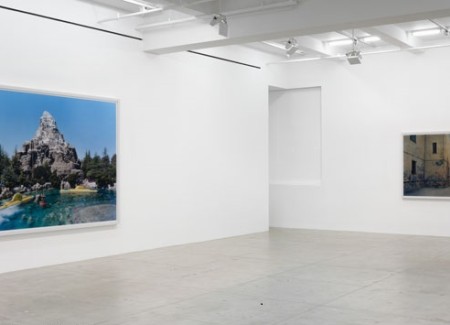JTF (just the facts): A total of 14 large c-prints, framed in white wood without mats, and hung in four of the galleries. No two prints are the same size, with the largest (“Measuring, Helmholtz-Zentrum,” Berlin, 2012) being 91 7/8 x 129 7/16 inches and the smallest (“Crack,” Anaheim, California, 2009) being 24 7/16 x 37 3/16 inches. All are horizontals, except one (“Cinema,” Anaheim California, 2013). The earliest image dates from 2005, while six date from 2013. Some prints are in editions of six, others in editions of ten. (Installation shots below, courtesy Marian Goodman Gallery, New York. Photography by Cathy Carver.)
Comments/Context: European artists and intellectuals should be forbidden from illustrating or writing about Disneyland. The place has become too enticing (and misleading) a target for lazy post-modernists. Seduced by its ersatz re-imagining of the world as a series of amusement rides and plasterboard fronts – symptoms of a country with no identity, according to Jean Baudrillard – foreign visitors don’t see our more buried, less civilized nature. As John Steinbeck wrote, “Yellowstone National Park is no more representative of America than is Disneyland.” (The same is true of Las Vegas, another singular place that attracts crude truisms.)
Thomas Struth’s six Disneyland pictures here aren’t offensive. Among the least condescending and judgmental photographers at work today—and one of the smartest—he never settles for easy laughs or sociology.
On the other hand, these images distort the focus of the show, which feels as if it were put together at the last minute, without a firm idea how its various elements would relate. He was likely more excited about the Disneyland pictures because they are his most recent—five of the six were done in 2013. Other pictures here mainly continue along the path he has been treading for the last 5 years: insider views of scientific labs and industrial sites.
The first room has a photograph of Tomorrowland that, had he chosen that as a title for the show, might have unified everything else. A busy, multi-tiered composition where the Finding Nemo Submarines circle against the background of the Matterhorn Bobsleds, and the Monorail comes around the bend, it’s like a toyland version of his panoramas in U.S. National Parks.
The theme of Disneyland as artificial paradise is further explored in a view of a manmade pond surrounded by vaguely Asian architecture; a stunningly realistic desert canyon that is the background for a race course; and the too cutely named “Crack,” which shows some actual vegetation growing between some synthetic boulders. (One of only two photograph in the show to emphasize nature, it is also the smallest. What we are building across the planet, Struth seems to be saying, has crowded out what we inherited.)
Struth knows that the light he finds on a scene is often better than anything he might have rigged. In several instances here, this aesthetic choice produces outstanding photographs. The high-intensity lamps on an operating table, most of the medical instruments sheathed in sanitary plastic, produces a ghostly reflective effect, as if the soul of the body under the scalpel were escaping its earthly bonds. Elsewhere, the dim illumination from skylights and unseen ceiling bulbs at a hot rolling mill in Duisberg, Germany suggest that this machine is more powerful than can be shown or perhaps imagined. Whether or not it is a salute to his teachers at the Düsseldorf Academy, Bernd and Hilla Becher, this is the most impressive picture in the show—a photograph as massive as the object it portrays.
This image and one of a blowout preventer in North Dakota are the only reminders of the industrial past. More prevalent are scenes of messy classrooms and labs at Georgia Tech, where out-of-sight students and professors have been tinkering with robots and drones.
With a few tweaks and more time, Struth might have done a show about how photography turns everything into the past, even pictures that claim to indicate what the future will be–indeed, especially those. Fifty years from now, scenes of what are now the latest advances in artificial intelligence will look as sweetly antiquated as photographs from the 1890s of Edison’s labs in Menlo Park, NJ or a 1945 magazine spread of John von Neumann and his IAS computer at Princeton. Disneyland has struggled mightily to upgrade its technology and hold on to its customer base, children and their parents. But we can’t help but notice that the company’s 1950s vision of Tomorrowland is by now–and was always–deeply nostalgic.
There is no faulting Struth’s technical chops. For clarity of detail and color in a super-sized print, he’s as good as it gets. What he thinks his photographs are revealing, though, is no longer clear. His colossal images of scientific experimentation, apart from giving monumental scale to provisional assemblages of technology, don’t take us closer to the process of thought behind the mess of cables and servers. As for the new direction signaled by the Disneyland series, with its themes of fabricated history and nature, hasn’t Hiroshi Sugimoto thoroughly mapped (exhausted?) that ground already?
Struth’s photographs used to be enlivened by the faces and gestures of actual people. But one of our foremost portraitists—sensitive to the dynamics of families and crowds alike—has lately purged them while documenting our post-modern economy. I miss their unpredictable, humanizing presence. There seems to be no good reason why they’ve gone missing and why they can’t reenter his frame of reference.
Collector’s POV: The works in this show range in price from €90000 to €200000 based on size. Struth’s photographs are consistently available in the secondary markets, with prices starting as low as $5000 and rising all the way past $1000000, with large, well known pieces routinely fetching six figures. One of Struth’s images topped $1.3M in 2013.











